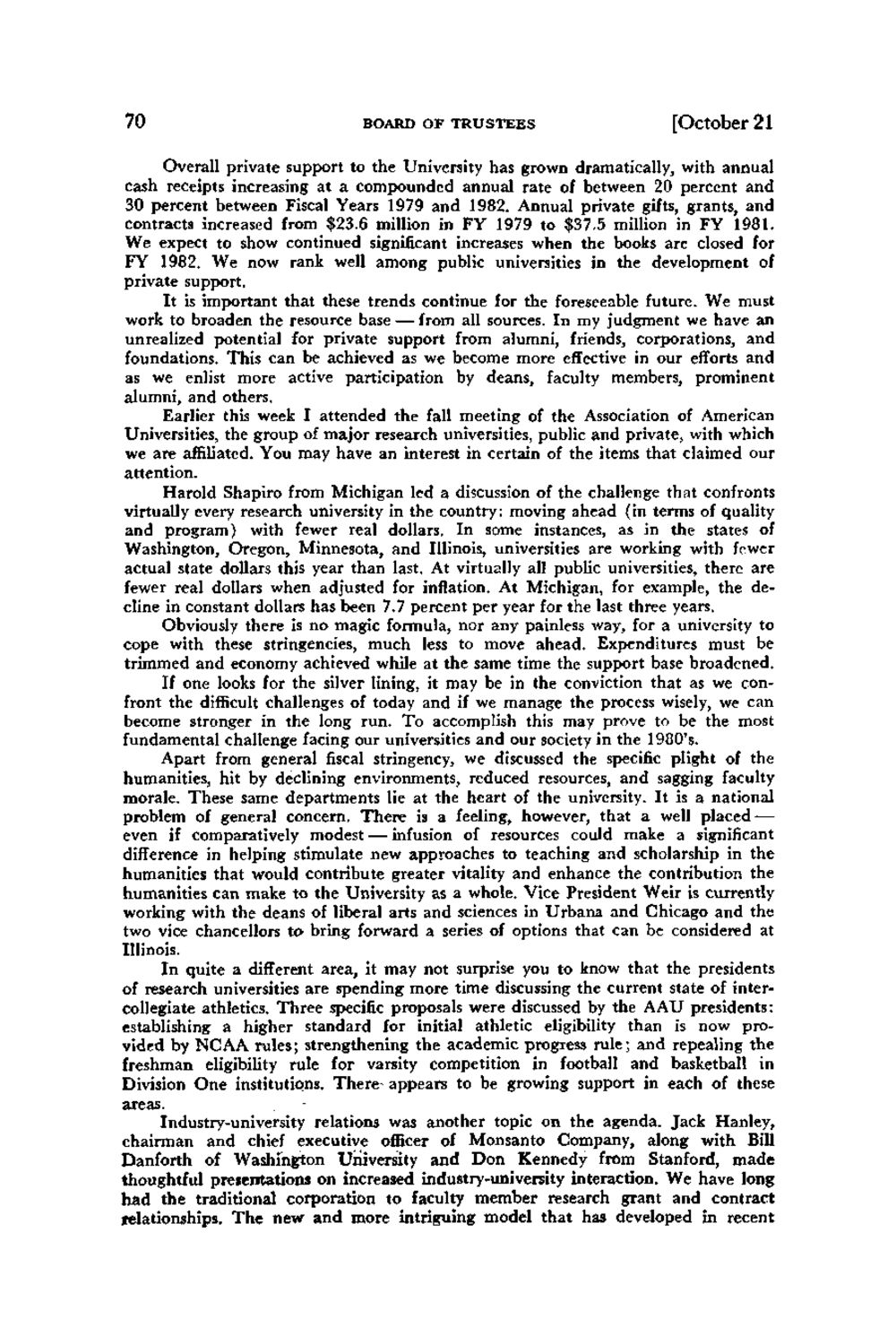| |
| |
Caption: Board of Trustees Minutes - 1984
This is a reduced-resolution page image for fast online browsing.

EXTRACTED TEXT FROM PAGE:
70 BOARD OF TRUSTEES [October 21 Overall private support to the University has grown dramatically, with annual cash receipts increasing at a compounded annual rate of between 20 percent and 30 percent between Fiscal Years 1979 and 1982. Annual private gifts, grants, and contracts increased from $23.6 million in FY 1979 to $37.5 million in FY 1981. We expect to show continued significant increases when the books arc closed for FY 1982. We now rank well among public universities in the development of private support. It is important that these trends continue for the foreseeable future. We must work to broaden the resource base — from all sources. In my judgment we have an unrealized potential for private support from alumni, friends, corporations, and foundations. This can be achieved as we become more effective in our efforts and as we enlist more active participation by deans, faculty members, prominent alumni, and others. Earlier this week I attended the fall meeting of the Association of American Universities, the group of major research universities, public and private, with which we are affiliated. You may have an interest in certain of the items that claimed our attention. Harold Shapiro from Michigan led a discussion of the challenge that confronts virtually every research university in the country: moving ahead (in terms of quality and program) with fewer real dollars. In some instances, as in the states of Washington, Oregon, Minnesota, and Illinois, universities are working with fewer actual state dollars this year than last. At virtually all public universities, there are fewer real dollars when adjusted for inflation. At Michigan, for example, the decline in constant dollars has been 7.7 percent per year for the last three years. Obviously there is n o magic formula, nor any painless way, for a university to cope with these stringencies, much less to move ahead. Expenditures must be trimmed and economy achieved while at the same time the support base broadened. If one looks for the silver lining, it may be in the conviction that as we confront the difficult challenges of today and if we manage the process wisely, we can become stronger in the long run. To accomplish this may prove to be the most fundamental challenge facing our universities and our society in the 1980's. Apart from general fiscal stringency, we discussed the specific plight of the humanities, hit by declining environments, reduced resources, and sagging faculty morale. These same departments lie at the heart of the university. It is a national problem of general concern. There is a feeling, however, that a well placed — even if comparatively modest — infusion of resources could make a significant difference in helping stimulate new approaches to teaching and scholarship in the humanities that would contribute greater vitality and enhance the contribution the humanities can make to the University as a whole. Vice President Weir is currently working with the deans of liberal arts and sciences in Urbana and Chicago and the two vice chancellors to bring forward a series of options that can be considered at Illinois. In quite a different area, it may not surprise you to know that the presidents of research universities are spending more time discussing the current state of intercollegiate athletics. Three specific proposals were discussed by the AAU presidents: establishing a higher standard for initial athletic eligibility than is now provided by NCAA rules; strengthening the academic progress rule; and repealing the freshman eligibility rule for varsity competition in football and basketball in Division One institutions. There appears to be growing support in each of these areas. Industry-university relations was another topic on the agenda. Jack Hanley, chairman and chief executive officer of Monsanto Company, along with Bill Danforth of Washington University and Don Kennedy from Stanford, made thoughtful presentations on increased industry-university interaction. We have long had the traditional corporation to faculty member research grant and contract relationships. T h e new and more intriguing model that has developed in recent
| |